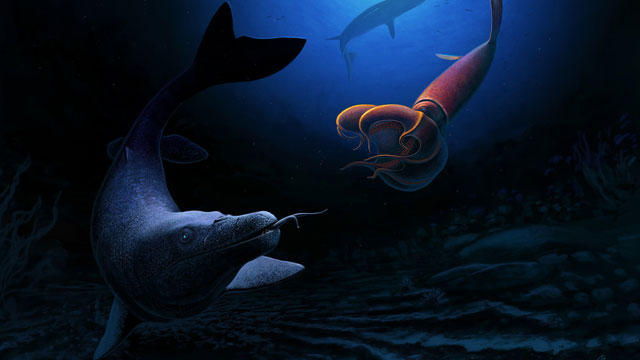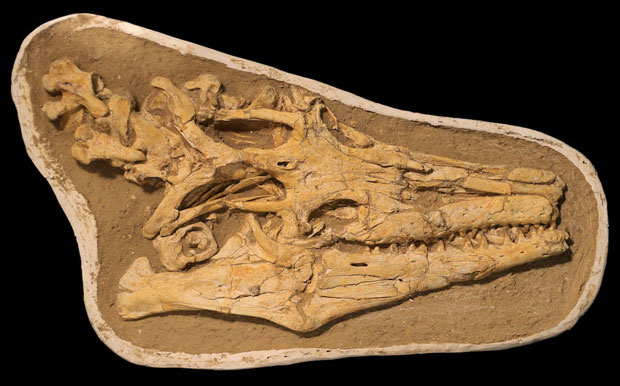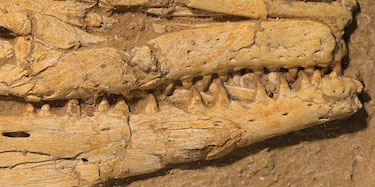This month (May 2021), has seen yet another scientific paper published describing a new species of mosasaur from the Late Cretaceous of Morocco. The newly described Pluridens serpentis reminds us that these whale-sized animals were related to snakes and lizards (Squamata). It may have sensed its marine environment in a similar way to extant sea snakes.

Morocco a Hot Bed of Late Cretaceous Mosasaurs
Mosasaurs were the last, great group of marine reptiles to evolve. They originated in the early Late Cretaceous and they were around for about 20 million years, a much shorter temporal range than other marine reptiles from the Mesozoic such as the ichthyosaurs and plesiosaurs. However, they were extremely successful and globally widespread with more than 40 different genera described.
The extensive phosphate beds of the Ouled Abdoun Basin in northern Morocco have proved to be a hot bed of mosasaur fossil remains. Thirteen mosasaur genera have been named and described from these Upper Cretaceous (Maastrichtian) deposits to date. For example, Everything Dinosaur wrote about the discovery of the specialised piscivore Gavialimimus almaghribensis in October 2020: Another New Species of Mosasaur from Morocco.
Based on Two Complete Skulls and Referred Jaw Material
Writing in the academic journal “Cretaceous Research”, scientists including Dr Nick Longrich (University of Bath), describe P. serpentis based on two complete skulls and referred jaw material. The skulls imply a total body length of around 6 to 8 metres, but the jaw material found indicates that Pluridens could have grown much larger, perhaps as big as 10 metres in length.
It had long, slender jaws lined with over a hundred tiny snake-like teeth which were well-adapted to grabbing small fish and squid. When compared to other mosasaurs, Pluridens had relatively small eyes, suggesting it had poor vision. It probably relied on other senses to understand its environment and to hunt. The upper snout (premaxilla), had dozens of openings for nerves (neurovascular foramina), hinting at the ability to hunt by sensing water movements and changes in pressure. These nerves may have been sensitive to tiny variations in water pressure, an adaptation seen in sea snakes.

Lead author of the study, Dr Longrich, (senior lecturer at the Milner Centre for Evolution, University of Bath), commented:
“Typically, when animals evolve small eyes, it’s because they’re relying more heavily on other senses. If it wasn’t using the eyes, then it’s very likely that it was using the tongue to hunt, like a snake. Many aquatic snakes and lizards – sea snakes and water monitors flick their forked tongues underwater, using chemical cues to track their prey. Mosasaurs would have resembled whales and dolphins, so it’s tempting to assume they lived like them. But they’re very different beasts – they’re huge lizards – so they probably acted like them.”
Thick, Robust and Heavy Jawbones
The researchers, who include scientists from the Natural History Museum of Sorbonne University (France), the University Cadi Ayyad in Marrakech and the OCP Group S. A. (both in Morocco), noted that the dentary (lower jaw bone) becomes massive and robust in the largest individuals, suggesting sexual selection and perhaps sexual dimorphism. In some species of extant beaked whales, the males use their jaws in combat (intraspecific combat). It is postulated that male Pluridens behaved in a similar way with the mandibles possibly functioning for combat as in modern beaked whales and some lizards such as Komodo dragons.

Pluridens serpentis
The newly described Pluridens serpentis lends weight to the theory that mosasaurs were continuing to specialise and diversify until the very end of the Cretaceous. It is the thirteenth species of mosasaur to be identified from Morocco and very probably not the last. Team members at Everything Dinosaur are looking forward to the publication of future scientific papers, once again highlighting the remarkable diversity of North African mosasaurs during the Maastrichtian faunal stage of the Cretaceous.
The scientific paper: “Pluridens serpentis, a new mosasaurid (Mosasauridae: Halisaurinae) from the Maastrichtian of Morocco and implications for mosasaur diversity” by Nicholas R. Longrich, Nathalie Bardet, Fatima Khaldoune, Oussama Khadiri Yazami and Nour-Eddine Jalil published in Cretaceous Research.
The Everything Dinosaur website: Prehistoric Animal Figures and Models.






Leave A Comment